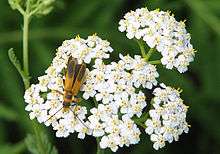Goldenrod soldier beetle
The goldenrod soldier beetle[1] or Pennsylvania leatherwing[2] (Chauliognathus pensylvanicus) is a species of soldier beetle (Cantharidae).
| Goldenrod soldier beetle | |
|---|---|
 | |
| Scientific classification | |
| Kingdom: | |
| Phylum: | |
| Class: | |
| Order: | |
| Family: | |
| Genus: | |
| Species: | C. pensylvanicus |
| Binomial name | |
| Chauliognathus pensylvanicus (DeGeer, 1774) | |
| Synonyms | |
| |
Nomenclature
The specific epithet pensylvanicus is Latin for "of Pennsylvania". "The spelling with one n was in common use at the time (de Geer says in the description that the specimen was sent to him from 'Pensylvanie'), so the species name based on it can't be corrected under the rules governing scientific names."[1]
Distribution
The species is native to North America, and is one of the most common species of soldier beetle in the Midwest.[3]
Parasites
Adult C. pensylvanicus may be infected by the fungus Eryniopsis lampyridarum. Shortly before death, by unknown mechanisms, dying infected beetles tightly clamp their mandibles into flower heads; 15–22 hours later, the fungus caused dead beetles to raise their elytra and expand their metathoracic wings in order to maximise infection of other beetles.[4] With their wings raised, the dead beetles may still attract mates as live males were observed mating with the deceased, infected females.[5]
References
- Chauliognathus pensylvanicus - Goldenrod Soldier Beetle, BugGuide
- Pennsylvania Leatherwing Beetle - (Chauliognathus pennsylvanicus), insectidentification.org
- "Goldenrod Soldier Beetle, Chauliognathus pennsylvanicus". Master Gardener Program. Retrieved 2019-07-24.
- Steinkrausa, Donald C.; Hajekb, Ann E.; Liebherrb, Jim K. (2017). "Zombie soldier beetles: Epizootics in the goldenrod soldier beetle, Chauliognathus pensylvanicus (Coleoptera: Cantharidae) caused by Eryniopsis lampyridarum (Entomophthoromycotina: Entomophthoraceae)". Journal of Invertebrate Pathology. 148: 51–59. doi:10.1016/j.jip.2017.05.002.
- Malhotra, Richa (9 June 2017). "Fungus creates zombie beetles that crave flowers before death". New Scientist. Retrieved 10 June 2017.